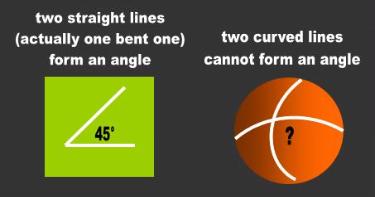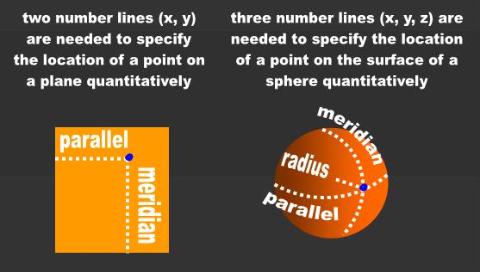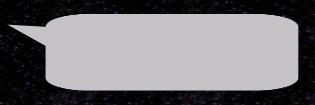- 1.0 The Euclidean triangle
Euclid defined a triangle as a rectilinear figure contained by three straight lines. In this context, the word
'contained' means that the three lines lie on the same plane for else we would have either a pattern as
opposed to a figure, or the figure is not a plane. Thus formed, the triangle encloses, as it name suggests,
three angles.
This definition is consistent with the requirement of the definition of angle: that it be formed on a plane.
What would the meaning of angle be if it were gauged with lines occupying different planes? What
would the definition of a degree be in the context of curved lines?
The mathematicians get around this requirement by drawing tangents to the curves. For instance, take
two curves that intersect. Since we cannot define an angle between the curves, we artificially place two
straight lines on top of them and where they meet is the angle the curved lines have. The angle of two
curved lines is deemed to be the angle formed by two tangents to the curved lines. This is how the idiots
of Mathematics extended the concept of angles to Riemann Geometry. This technique masks the fact
that an angle is still a plane pattern.
2.0 The Riemann ‘triangle’
With this groundwork we can now see why the relativistic Riemann triangle is not a triangle at all. Recall that
the Riemann 'triangle' rests on the surface of a sphere which, according to relativists, makes its internal
angles add up to more than 180º. The problem is that Riemann’s ‘triangle’ lacks the most important property
of triangles: angles! Whether under Euclid's definition, present day definition, or my proposed definition, an
angle is perceived to be on a plane. Riemann's contraption does not rest on a plane, and it is misleading to
label it a triangle.
The traditional Euclidean triangle is a plane figure that has two dimensions: width and height. In
Mathematics,any point can be specified with an ordered pair (x, y). the mathematicians call these variables
'dimensions' or 'coordinates.' In Science they are known as number lines, in turn known respectively as
parallel and meridian. A triangle can be thought of as a cross-section of a pyramid or a cone.
A location on the alleged Riemann 'triangle,' on the other hand, must be referenced using three number
lines known as parallel, meridian, and radius. It takes three numbers to specify the location of a point on a
sphere quantitatively, which is where the mathematical physicists always place the Riemann triangle. For
unknown reasons, the mathematicians always forget the altitude or radius of the sphere, the distance
traveled from the center of the sphere to the point. This is the reason relativists regard the surface of a
sphere to be two-dimensional (2-D) rather than 3-D.
However, even if we only consider the shell and not the solid (i.e., the ball), we still need to specify the
distance from the center of the sphere. A sphere is defined as all points equidistant from a center. The
center is an integral part of the definition that the idiots of Mathematics themselves gave the sphere. The
mathematicians need the center of the sphere to define the sphere, but want you to believe that the center
is not part of the sphere. The mathematical sphere is thought of as being hollow. The mathematical sphere
consists solely of the shell.
Therefore, pursuant to the mathematical definition of dimension (number of numbers), Riemann’s alleged
triangle is 3-D:
- " when two-space is curved into a third dimension, the angles always total either less than
180 degrees (if the curvature is hyperbolic, or 'open') or more than 180 degrees (if the
curvature is spherical, or 'closed')." (p. 198) [1]
A Riemann triangle is a peculiar slice of a sphere devoid of thickness. We cannot manufacture a Riemann
triangle because, despite that it takes up 3 dimensions it is not a 3-D object. The Riemann triangle is not a
triangle because it has no angles, either according to the current definition of angle or according to the
one I propose here. An angle is formed by two straight lines on an imaginary plane. The Riemann ‘triangle’
doesn’t meet either criterion. A Riemann triangle is constituted by curves, and there is no dictionary that
defines angles in terms of curves!
Indeed, pursuant to contemporary ‘constructions,’ triangles and circles are not geometric figures, but
rather imaginary areas enclosed by itineraries that relativists mistake for boundaries. The edges of all
geometric figures of Mathematical Physics are traces of a moving point: paths. We are watching a movie
of a bunch of footprints in the making.
The Riemann triangle fails the 2 requirements of a triangle. It neither has angles nor is it on a 2-D plane.
An angle is formed by straight lines. A Riemann Triangle is made of curves. A triangle is defined as a flat
geometrical figure, i.e., lying or occupying no more than 2-D. The Riemann Triangle is 3-D. The Riemann
triangle is not a solid because it has no width. It only has the ‘skin’ of a sphere. But then we cannot look
at any triangle sideways and realize that it is a triangle. A triangle can only be visualized head on. Without
the sphere, the Riemann triangle is nothing (Fig. 3).
|
Fig. 3 |

| I don't know, Bill. I've been seeing them too. It must be some unknown bug going around. |
Fig. 2 |
| Can we form an angle with curves? Euclid defined an angle using straight lines. The mathematicians got around the requirement by placing straight lines on curved lines. The resulting 'angle' has the magnitude formed by the vertex of the straight lines. In this indirect manner, the mathematicians were able to extend the concept of angles to curved lines. They subsequently invented the curved 'tri' 'angle'! |
| You cannot see a Euclidean triangle sideways You can see a Riemann 'triangle sideways because it is 3-D. yet, you cannot manufacture a Riemann triangle because it has zero thickness! |


| The mathematicians require two number lines known as parallel and meridian to quantita- tively specify a location on a plane, for instance on a rectangle. The mathematicians require three number lines known as parallel, meridian, and radius to specify a location on a sphere. For unknown reasons that the psychiatrists are still researching, the mathematicians never include the radius. This in spite of the fact that they define the sphere as having a center. In the religion of Mathematical Physics, a sphere is not 3-D, but rather 2-D. |

- Module main page: The 3-D planes of Mathematics
Pages in this module:
- 1. What is a plane?
2. Is a plane the same as a surface?
3. What does an infinite triangle look like?
4. Rough planes
5. How do you tilt a square?
6. This page: What is a triangle?
7. What is a circle?


Doc, I've been seeing, hic, pink
curved triangles lately. What
could it, hic, possibly mean?
curved triangles lately. What
could it, hic, possibly mean?
| Adapted for the Internet from: Why God Doesn't Exist |
| What is a Triangle? |
- ________________________________________________________________________________________
- Copyright © by Nila Gaede 2008
